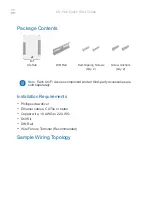
9
NAF Duball DL Ball Valves NFENIM4163-00-A4 05/17
flowserve.com
10.3 Reassembly of the valve
To replace parts, see sections 10.4-10.6 below. After the inspection
and/or part replacements have been made, reassemble the valve as
described below. For part numbers, see Figure 5. For spare part kits,
refer to Table 2.
1.
If the Pocket ball has been lapped with the seat rings, it is of
great importance that the Pocket ball and seat rings are cleaned
before being assembled in the valve body. Use a suitable solvent
and carefully clean the lapping paste from the Pocket ball and
seat rings. Make sure that no lapping paste remains.
2.
Grease the seat rings (4) with Klüber Barrierta L55/3 grease (or
similar). The coat of grease must be thin and evenly distributed.
3.
Fit the body seal (14) between the two halves (1, 2) of the body.
It is always recommended to use a new body seal from the
stem seal kit.
4.
Fit the ball (3) in the main body (1). See Figure 4. Then fit the
body cover (2). Note: The main body (1) and body cover (2) will
only fit in one position.
5.
Check that the Pocket ball opening is facing upwards in the
direction of the body cover (2). If not, turn the ball 180 degrees.
6.
Lubricate all studs/bolts (17, 18) with suitable anti-galling
grease.
7.
Lubricate the contact surface of the nuts (19) with a suitable
anti-galling grease and put the nuts onto the studs/bolts (17,
18). Start to tighten the bolted joint of the two body halves
(1, 2) of the body alternately in several stages in a diagonal
sequence. Make sure that the body seal (14) remains in its
designated position.
8.
Inspect that there is no visible gap between the body halves and
finally tighten according to the torque in accordance with Table 3.
9.
Operate the valve between the closed and open positions.
Table 3. Required torque for the bolted joint of the two body halves
Bolt
Torque Nm
Bolt
Torque Nm
UNC 1/2”
89
M12
76
UNC
5
/
8
”
175
M16
187
UNC 3/4”
308
M20
364
UNC
7
/
8
”
493
M24
629
UNC 1”
737
10. There should be a small gap between the Pocket ball and the
seat ring to get the correct torque while restricting big particles
from entering the body. Inspect that the gap between the Pocket
ball (3) and seat ring (4) is correct by moving the Pocket ball to
approximately 45°. The gap between the Pocket ball and seat
ring should measure approx. 0.2-0.3 mm.
11. If possible, pressure test the valve with water to check its tight-
ness after reassembly. Testing should be done when the Pocket
ball is in filling position. If the valve has been pressure tested,
please check and, if needed, re-tighten the bolts according to
step 3 above.
Testing with the use of gaseous media is not recommended
due to safety issues. Testing the valve body tightness should
not be performed at a pressure higher than 1.5 x maximum
allowed working pressure. Refer to Technical Bulletin
NFENTB4163. Due to the floating action of the ball, the ball
needs a certain volumetric flow to effectively seal the ball
against the seat. We recommend for valve sizes DN150/6”
and larger, that the inlet pipe connection is a minimum of 25
mm/1”.
10.4 Replacing seat rings
To remove the locket seat rings, use a suitable precision power tool
with a cutting blade (or similar equipment) to carefully remove the
lockings from the seat ring without further damaging the seat ring.
To ensure tightness of the valve, fit new seat rings (4) if the original
ones are severely worn or damaged.
Visually inspect the sealing surfaces of the seat rings (4). A groove on
the inside diameter of the seat facilitates the removal of the seat ring.
Minor damage to the seats can be rubbed down with fine emery cloth.
Check the seats on a face plate to ensure that they are perfectly flat.
Change the seats if they are severely worn or damaged.
The ball (3) and seat rings (4) can be temporarily overhauled by
lapping them together. This can be done manually with a compound
with grit size 200. Take great care to ensure that the ball and seat rings
do not become oval.






























